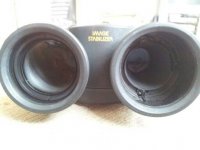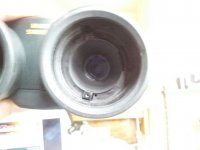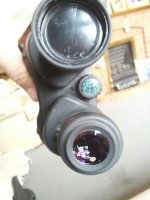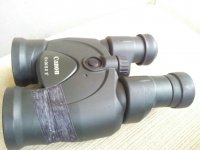I've just recieved a well used (to say the least!) pair of Canon 12x36IS II binoculars from Ebay. They look like they've been used in a war. As a weapon. Rubber coating is marked in places and missing on high points, the left optical tube is completely unserviceable - missing lens, objective tube all but snapped off up to the base of the main body of the bins. However, the right tube (& dioptre) and IS are working brilliantly so I'm using them as an IS 'monocular'. And yes - I actually bought them knowing this! Bit of a gamble but got them for £66 so can't complain! :t:
Firstly, is there a manual available anywhere? I can't find one online, including on Canon's site which simply says 'sorry, cannot find what you're looking for' when I select the manual. Not sure if these are an early example or not, has the serial number 96000215 if it helps to date them.
This may be a silly question but can I adjust the focus with the IS engaged? I've done it once but the focussing was stiffer. Is this something that I really shouldn't do or is it OK? Edit: if anyone's unsure it's the version where I have to press and hold the IS button to keep it engaged, it stops working the moment I release the IS button.
Lastly, considering the condition of the binoculars I imagine the IS system has seen a lot of use/abuse over the years. Would it be easier on the system to use it in short bursts or for longer, but with less frequent activations? Are there any kind of checks/servicing that I could do to help prevent any future problems?
I'm very very impressed with the view through these, might have to save up for a less abused pair of 12x36s or even a brand new pair. Looking at what these have been through though it would suggest that the IS circuitry should hold up to a fair amount of abuse without failing, whatever broke/smashed the left objective lens assembly looked like quite a heavy impact! Though I shouldn't speak too soon in case it promptly fails on me...
Firstly, is there a manual available anywhere? I can't find one online, including on Canon's site which simply says 'sorry, cannot find what you're looking for' when I select the manual. Not sure if these are an early example or not, has the serial number 96000215 if it helps to date them.
This may be a silly question but can I adjust the focus with the IS engaged? I've done it once but the focussing was stiffer. Is this something that I really shouldn't do or is it OK? Edit: if anyone's unsure it's the version where I have to press and hold the IS button to keep it engaged, it stops working the moment I release the IS button.
Lastly, considering the condition of the binoculars I imagine the IS system has seen a lot of use/abuse over the years. Would it be easier on the system to use it in short bursts or for longer, but with less frequent activations? Are there any kind of checks/servicing that I could do to help prevent any future problems?
I'm very very impressed with the view through these, might have to save up for a less abused pair of 12x36s or even a brand new pair. Looking at what these have been through though it would suggest that the IS circuitry should hold up to a fair amount of abuse without failing, whatever broke/smashed the left objective lens assembly looked like quite a heavy impact! Though I shouldn't speak too soon in case it promptly fails on me...
Last edited:







